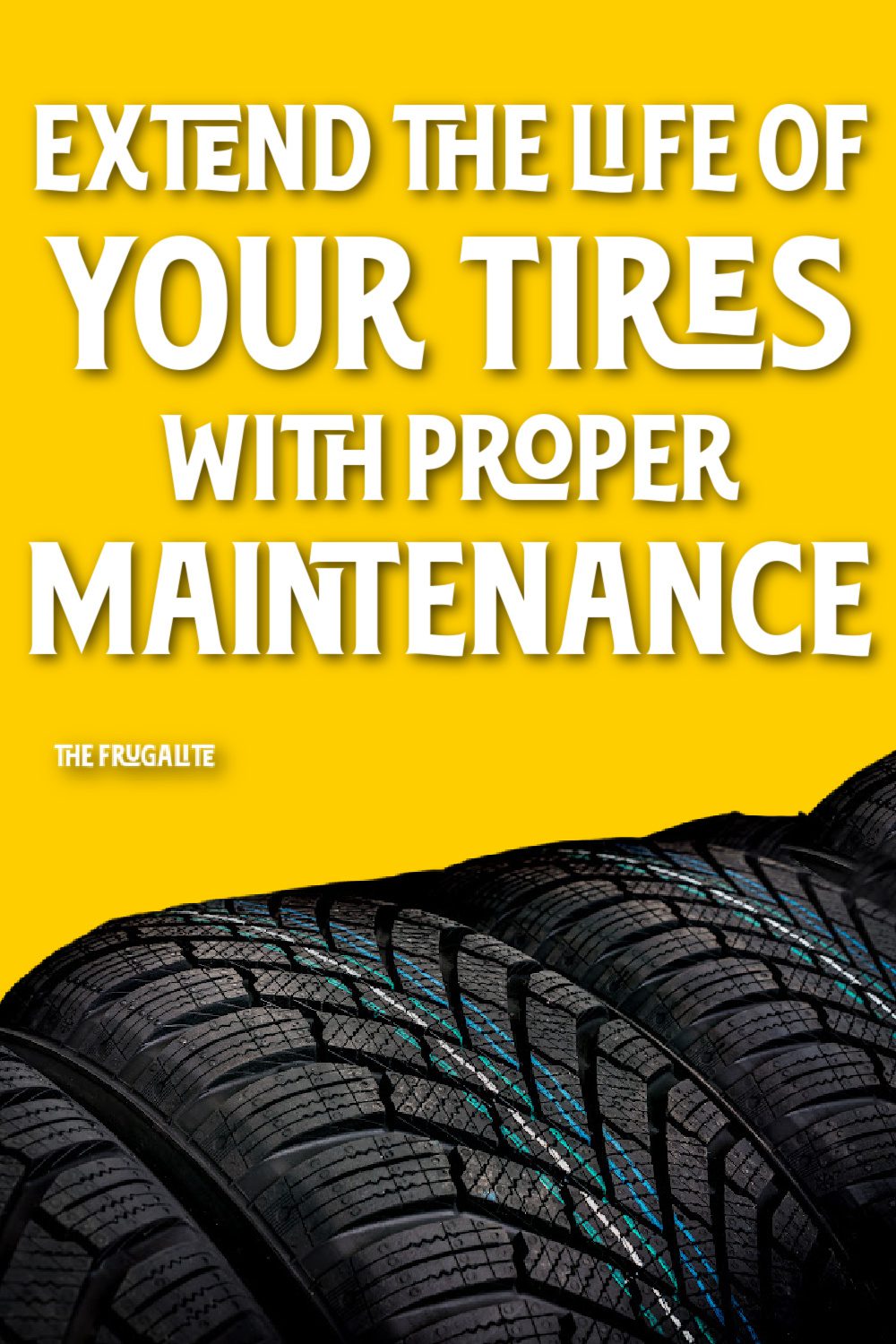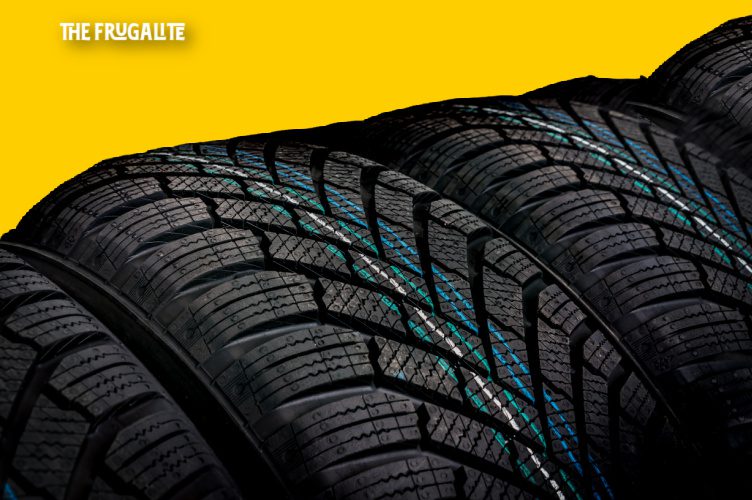(Psst: The FTC wants me to remind you that this website contains affiliate links. That means if you make a purchase from a link you click on, I might receive a small commission. This does not increase the price you’ll pay for that item nor does it decrease the awesomeness of the item. ~ Daisy)
By the author of The Ultimate Guide to Frugal Living and The Flat Broke Cookbook
Some people don’t pay any attention to their tires until they have a flat or they’re told they need to replace them. Some people are making a mistake.
When I worked at a car dealership for a decade, I saw that it was the people who properly maintained their tires who got the most life from them. Below are some tips for keeping your tires in tip-top shape.
Decent tires are essential for the safety of your vehicle.
Maintaining the tires on your car is essential for ensuring safe and efficient driving. Properly inflated and well-maintained tires can help improve fuel efficiency, extend the life of your tires, and reduce the risk of a tire blowout or other accidents.
Doing some of it yourself not only saves you money on mechanic fees but also empowers you to take control of your vehicle’s maintenance and helps you become more knowledgeable about its overall condition.
Here’s a step-by-step guide on how to check and maintain your tires.
Here are the things you need to know how to do with your tires.
Some things, you can and should know how to handle yourself.
Check the tire pressure. It’s important to maintain the proper tire pressure to ensure that your tires are performing at their best. Underinflated tires can cause poor fuel efficiency and handling, while overinflated tires can cause a harsh ride and increase the risk of a blowout. To check the tire pressure, you will need a tire pressure gauge. You can find the recommended tire pressure for your car in the owner’s manual or on a placard located on the driver’s side door jamb, inside the fuel filler door, or in the glove box.
Warning: Never exceed the maximum tire pressure listed on the sidewall of your tire. Overinflated tires can cause a harsh ride and increase the risk of a blowout.
Check the tire tread depth. Proper tread depth is essential for maintaining traction and stability on the road. To check the tread depth, you can use a tread depth gauge or a simple penny test. To do the penny test, simply insert a penny into the tread groove with Lincoln’s head facing down. If you can see the top of Lincoln’s head, it’s time to replace your tires.
Be alert for damage. Look for any visible signs of damage on your tires, such as cuts, bulges, or tread separation. If you notice any damage, it’s important to have it checked out by a mechanic as soon as possible.
Change your tire to the spare using the jack. If you don’t already know how to do this, I strongly urge you to learn how to change the tire to your spare using the jack that you keep in your car. I consider this an essential skill for everyone, including women. Not only will this get you back on the road far more quickly than calling AAA, but it may also help to keep you safe. Heaven only knows how many women have been abducted, raped, or killed when they experienced a flat tire in a remote area. If they didn’t know how to handle it themselves, they had to wait for someone to stop. If that person had bad intent…well, you watch the news. My daughters were both taught to change a tire before they were taught to drive.
Being able to change your tire doesn’t mean that you can’t ever use the free roadside assistance that comes with your insurance policy. It just means that you won’t be stranded if, for some reason, roadside assistance is not available in a timely fashion.
Here’s what you might need a mechanic to do to maintain your tires.
I’m not saying that some folks can’t manage all of these tasks on their own but I generally leave them to my mechanic.
Rotate your tires. To ensure even wear on all of your tires, it’s a good idea to rotate them regularly. The frequency of rotation will depend on your driving habits and the type of tires you have. Consult your owner’s manual or a mechanic for recommendations on how often to rotate your tires. Before I began using synthetic oil for more time between oil changes, I had them rotated every other oil change. Now I have them rotated every oil change. Some places will do this for free while changing your oil.
Check the alignment. Poor alignment can cause uneven tire wear and negatively impact the handling of your vehicle. To check the alignment, you can do a simple visual inspection by looking at the wear patterns on your tires. If the wear is more pronounced on one side of the tire than the other, it could be a sign of poor alignment. You may notice that if you take your hands off the wheel while driving at highway speeds, your vehicle drifts to one side. In really bad cases you’ll be able to feel the pull in the steering wheel. Your mechanic can check the alignment and make certain it isn’t caused by an issue with your suspension.
Check the balance. Unbalanced tires can cause a rough ride and increase tire wear. To check the balance, you can have a mechanic perform a balance check using a balancer machine.
Important clues something may be wrong with your tires
If you’re paying attention, your tires will often warn you of impending trouble.
If you notice any unusual vibrations or noise while driving, it could be a sign of a tire problem. In this case, it’s important to have your tires checked out by a mechanic as soon as possible.
If you notice any uneven wear on your tires, it could be a sign of a problem with your alignment or balance. In this case, it’s important to have your tires checked out by a mechanic to ensure that they are performing at their best.
Maintaining your tires can prolong their life and save you money.
Maintaining your tires is an important part of keeping your car running safely and efficiently. By regularly checking and maintaining your tires, you can extend the life of your tires and improve the performance of your vehicle. So don’t forget your tires – take a few minutes to check and maintain them regularly, and you’ll be rewarded with improved performance and peace of mind on the road.
Do you have any additional tire maintenance tips? Have you had good luck prolonging the life of your tires? Let us know about it in the comments.
More Frugal Automotive Content
-
How to Save Money by Boosting Your Car’s Fuel Efficiency
-
How My Beater Car Has Saved Me Thousands of Dollars
-
When to Say Goodbye to an Old Car
About Daisy
Daisy Luther is a coffee-swigging, adventure-seeking, globe-trotting blogger. She is the founder and publisher of three websites. 1) The Organic Prepper, which is about current events, preparedness, self-reliance, and the pursuit of liberty; 2) The Frugalite, a website with thrifty tips and solutions to help people get a handle on their personal finances without feeling deprived; and 3) PreppersDailyNews.com, an aggregate site where you can find links to all the most important news for those who wish to be prepared. Her work is widely republished across alternative media and she has appeared in many interviews.
Daisy is the best-selling author of 5 traditionally published books, 12 self-published books, and runs a small digital publishing company with PDF guides, printables, and courses at SelfRelianceand Survival.com You can find her on Facebook, Pinterest, Gab, MeWe, Parler, Instagram, and Twitter.












4 thoughts on “Extend the Life of Your Tires with Proper Maintenance”
The mention of an issue with the suspension is no joke. I once had to have all four tires replaced because of a wear-down matter. The tire dealer changed them out but refused to do an alignment because part of the front suspension was too worn and needed replacing BEFORE an alignment could be done reliably.
When you do a routine tire pressure check on your vehicle(s), do you also check the pressure in your SPARE tire? Lots of people fail to do this. The worst time to discover this is when you have a surprise flat and your spare needs air as well.
Another discovery to make is whether or not your spare tire is carried where you can easily reach it. Traditionally most spares were stored in the vehicle trunk for ease of access. These days some are stored UNDER the vehicle inside a rack and secured by some fasteners for which you may not the tools to loosen or have a way to raise the vehicle to get to that spare. (A car jack in a sandy ditch can be next to useless…) FIND OUT ahead of time so you can plan how to work around such surprise gotchas.
Also realize that some spares these days are a smaller size than the four basic tires … and are not meant for trips much longer than a careful short trip to a repair shop. They are not intended to complete a cross-country trip for you. Some people even go to the trouble of replacing their skinny spare with a full sized spare tire in case of such long distance needs or possibilities.
Tires sometimes go flat at the worst possible times — especially while driving at night. I am seeing ads for magnet-based flashing lights to stick on the rear and sides of your vehicle to warn other drivers NOT to smash into your vehicle. They can also buy you time to call for help if needed or wait until someone stops to help. If you don’t have your cell phone with you (or if its battery is out of juice) or you’re out of range from the nearest cell tower … those magnet-based flashing lights could buy you some desperately needed time.
There’s also the not-so-little issue of the longevity of your engine. I’m seeing a video on YouTube about how to maintain your engine so it can last up to 400,000 miles. That’s a sufficiently sizeable benefit to more than dwarf the gains from just tire maintenance.
–Lewis
Some tire places (Discount Tire is the one I know best) will air up and rotate your tires for free, especially if you bought your tires from them.
Great advice in this article!
You forgot the most important tip of all; watch your DRIVING! Your tires will wear faster at higher speeds. Backing off a little will save your tires. It’ll also save wear on the rest of the car! The same goes for accelerating, braking, and cornering. Go easy on all of these and your tires will last WAY longer!
Also; always check your tire pressure “cold.” The best time to check is when the car has been sitting several hours and doesn’t have the sun shining on the tires. For most folks this in the early morning. Driving the car for even a few miles before checking will affect this reading by several pounds! The only exception to this is if your tires are nitrogen-filled. Nitrogen is inert. It doesn’t expand or contract with changes in temperature. Technically, the pressure in the tires should always stay the same. Just know though, that if your Nitrogen-filled tires get low and you add air instead of Nitrogen, you’ve just defeated the benefit of nitrogen-filled tires!
I buy my tires at Costco. They have only three brands and all are good. They rotate your tires for free. Be sure to make an appointment, as their tire centers get busy from the moment the store opens.